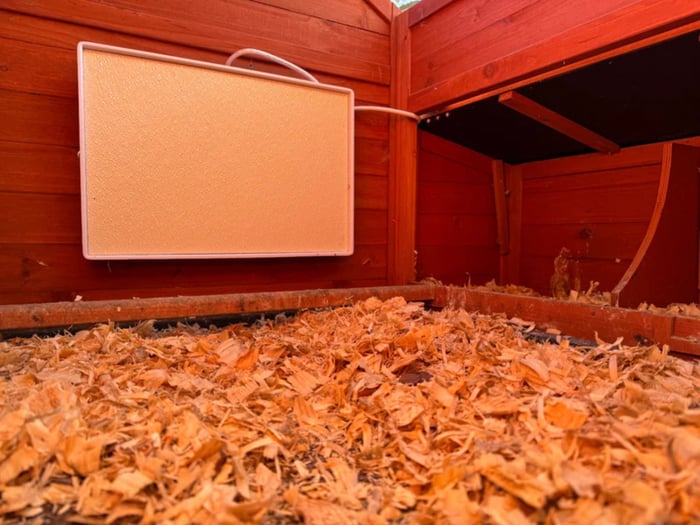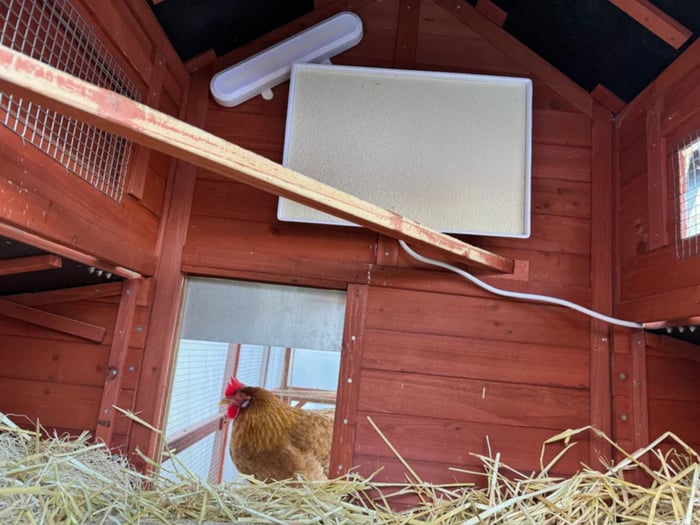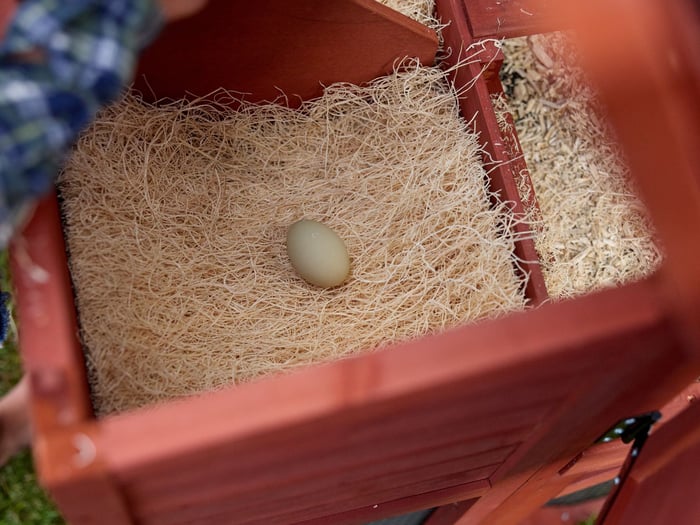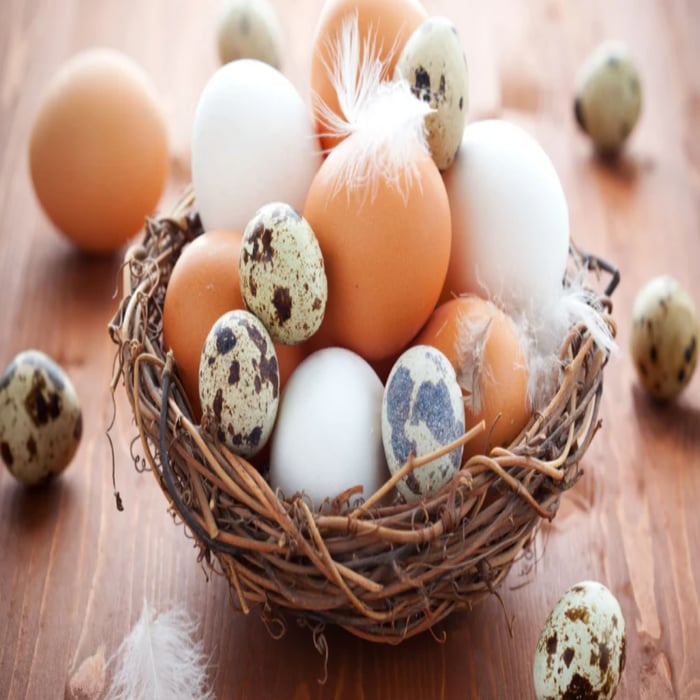Table of Contents
Heat Lamps for Chickens: Let’s Talk About It
When winter settles in and the nights grow longer, many chicken keepers start to wonder how their flocks will handle the cold. It’s a fair question—after all, no one wants to imagine their hens shivering through a Wyoming blizzard or a frosty Midwestern morning. But when it comes to heat lamps for chickens, more warmth doesn’t always mean more safety.
While those glowing red bulbs have been a longtime symbol of winter chicken care, they’re also one of the most dangerous items you can put inside a coop. Each year, barns and backyard setups go up in flames due to one simple mistake: a heat lamp that fell, tipped, or overheated. It happens fast, and the results are devastating.
The truth is, chickens are far more resilient than most people realize. With the right setup, good ventilation, and a few thoughtful winter upgrades, your flock can stay safe and comfortable, without relying on risky heat lamps for chickens.
Why We DO NOT Recommend Heat Lamps
First thing's first: Fire. Hazard. These heat lamps may be safely used for chick brooders, but when it comes to using one in your coop, , they’ve caused countless fires. The problem isn’t just user error, it’s that heat lamps are simply too unpredictable.
The bulb itself can reach dangerously high temperatures. If a clamp loosens, a cord frays, or a curious hen flaps too close, that lamp can ignite straw, bedding, or wood in seconds. Many seasoned chicken owners have heartbreaking stories of coops lost to fires caused by heat lamps for chickens.
Even when a fire doesn’t occur, heat lamps can cause other issues. Artificial heat keeps chickens from naturally acclimating to cold weather. If the lamp goes out suddenly, say, from a power outage, your hens can struggle to regulate their body temperature. The sudden temperature drop is more stressful than the steady chill of winter.
A safe, dry, draft-free coop provides everything your flock needs to thrive. With a little insulation (which is as simple as the bedding you would put down in their poop tray) and good airflow, most adult chickens handle freezing temperatures without trouble.

IMAGE IS AN EXAMPLE OF WHAT NOT TO DO. PLEASE DON'T DO THIS!
How Chickens Stay Warm on Their Own
A healthy chicken maintains a body temperature between 105°F and 107°F - yes, you read that right! Their feathers act as incredible insulation. When hens roost at night, they puff up their feathers to trap warm air close to their skin, creating a natural layer of protection.
Even on a subfreezing night, the air inside a coop can stay several degrees warmer than outside, especially if it’s well-built and free from drafts. That’s why focusing on coop design rather than adding heat lamps for chickens is usually the smarter move.
You may notice your hens standing on one leg, tucking their heads under their wings, or huddling together. These are all natural ways they conserve heat. As long as they’re active, eating, and not showing signs of distress, they’re perfectly fine in cold weather.
Still, it’s important to keep an eye out for signs of frostbite. Look for pale or dark spots on combs, wattles, and toes. Frostbite usually happens when moisture builds up inside the coop, not from cold alone. Keep the bedding dry, provide ventilation to let humidity escape, and make sure there’s no condensation collecting overnight.

When Heat Might Be Necessary
While most adult chickens can easily handle winter temperatures, there are times when a little extra warmth helps. Newly hatched chicks, injured or sick birds, or flocks living in areas that see extended subzero temperatures may need supplemental heat.
But even in these cases, you’ll want to steer clear of traditional heat lamps for chickens. There are safer, more energy-efficient options available today that provide warmth without the fire risk.
A Safer Alternative to Heat Lamps for Chickens
If you’re looking for a reliable way to keep your flock warm, consider switching to a modern, low-wattage heater designed specifically for poultry, like this Chicken Co. Coop Heater.
This heater provides gentle radiant warmth rather than an open heat source. It’s built with safety and efficiency in mind, so you can keep your birds comfortable without worrying about fire hazards. It even includes an emergency shut-off feature that activates automatically if temperatures climb too high.
Some of the standout features include:
Easy installation: The quick-release mounting bracket lets you attach it to a wall or ceiling—no tools required.
Energy efficiency: On average, it saves about $3–$5 per week compared to running an infrared 250-watt bulb.
Multiple sizes: Choose from models that perfectly fit the Chicken Coop Company’s designs:
Leghorn Cottage & Orpington Lodge = 11” x 16”
Rhode Island Coop = 11” x 30”
USA-made quality: Designed and manufactured in the USA for dependable performance all winter long.
Unlike traditional heat lamps for chickens, this heater doesn’t get dangerously hot to the touch. Instead, it radiates consistent warmth that feels natural to your flock. Many chicken keepers who switched to the Big Chicken Co. Coop Heater mention how much calmer and cozier their hens seem during cold spells.

Insulating the Coop the Smart Way
One of the best ways to reduce the need for any heating device is to make sure your coop holds warmth effectively. Start by inspecting for gaps or drafts—especially around doors, windows, and rooflines. A coop should be well-ventilated but not drafty.
Adding insulation doesn’t have to be complicated or expensive. Here are a few effective ways to retain heat naturally:
Cover their run: If your chickens are in an enclosed run, make sure they have a covered run, free of snow so they do not get frostbite on their feet! Some use tarps or curtains to cover their run, and our storm panels fit perfectly onto existing coops and help block wind and snow while allowing light in.
Deep litter method: Let bedding build up in layers over time. The natural composting process releases gentle heat and keeps the floor insulated.
Dry bedding: Keep straw or hemp shavings clean and dry to prevent dampness.
The goal isn’t to make the coop airtight—it’s to block drafts at roost level while still allowing moisture to escape. A little fresh air is essential for healthy chickens.
Keeping an Eye Out for Cold-Weather Problems
Even if you’re not using heat lamps for chickens, winter chicken keeping requires a bit of extra attention. Keep waterers from freezing with heated bases or insulated containers, make sure feed stays dry, and ensure roosts are wide enough for hens to cover their toes when they perch.
If you notice any hens isolating themselves, looking lethargic, or refusing to eat, bring them inside temporarily to warm up and recover. But remember—most healthy birds handle winter just fine with proper housing and nutrition.

Final Thoughts
Chickens are tougher than we give them credit for. While it’s tempting to rely on heat lamps for chickens, the risks far outweigh the rewards. Fire danger, energy costs, and dependency on artificial warmth all make heat lamps a poor choice for long-term flock health.
Instead, focus on what truly matters: a secure, draft-free coop, good ventilation, dry bedding, and access to fresh food and water. If you do want a little extra warmth, choose a product designed for poultry safety—like the Big Chicken Co. Coop Heater. It’s energy-efficient, reliable, and gives you peace of mind knowing your flock is safe through every snowstorm.
Because at the end of the day, winter chicken keeping shouldn’t be about fighting the cold—it should be about working with nature, not against it.
FAQs
Do chickens need heat in the winter?
Most adult chickens don’t need heat lamps for chickens or other heat sources. As long as their coop is dry and draft-free, they’ll stay comfortable even in freezing temperatures.
Are heat lamps safe to use in chicken coops?
No. Heat lamps for chickens pose a major fire risk and can cause severe injuries or total coop loss. Safer alternatives like radiant heater panels are a better choice.
What’s a safe temperature range for chickens?
Chickens tolerate temperatures well below freezing. Most breeds do fine as long as it doesn’t stay below 0°F for long periods.
How can I prevent frostbite in my flock?
Keep the coop dry, improve ventilation, and apply a thin layer of petroleum jelly to combs and wattles in extreme cold.
What’s the best alternative to a heat lamp?
A low-wattage radiant panel provides safe, even warmth without open flames or exposed bulbs.


.png)


